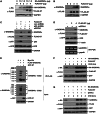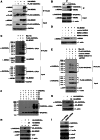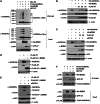Ribosomal protein S7 regulates arsenite-induced GADD45α expression by attenuating MDM2-mediated GADD45α ubiquitination and degradation
- PMID: 23563151
- PMCID: PMC3664810
- DOI: 10.1093/nar/gkt223
Ribosomal protein S7 regulates arsenite-induced GADD45α expression by attenuating MDM2-mediated GADD45α ubiquitination and degradation
Abstract
The stress-responding protein, GADD45α, plays important roles in cell cycle checkpoint, DNA repair and apoptosis. In our recent study, we demonstrate that GADD45α undergoes a dynamic ubiquitination and degradation in vivo, which process can be blocked by the cytotoxic reagent, arsenite, resulting in GADD45α accumulation to activate JNKs cell death pathway, thereby revealing a novel mechanism for the cellular GADD45α functional regulation. But the factors involved in GADD45α stability modulations are unidentified. Here, we demonstrated that MDM2 was an E3 ubiquitin ligase for GADD45α. One of MDM2-binding partner, ribosomal protein S7, interacted with and stabilized GADD45α through preventing the ubiquitination and degradation of GADD45α mediated by MDM2. This novel function of S7 is unrelated to p53 but seems to depend on S7/MDM2 interaction, for the S7 mutant lacking MDM2-binding ability lost its function to stabilize GADD45α. Further investigations indicated that arsenite treatment enhanced S7-MDM2 interaction, resulting in attenuation of MDM2-dependent GADD45α ubiquitination and degradation, thereby leading to GADD45α-dependent cell death pathway activation. Silencing S7 expression suppressed GADD45α-dependent cytotoxicity induced by arsenite. Our findings thus identify a novel function of S7 in control of GADD45α stabilization under both basal and stress conditions and its significance in mediating arsenite-induced cellular stress.
Figures







Similar articles
-
Transcriptional repression of IKKβ by p53 in arsenite-induced GADD45α accumulation and apoptosis.Oncogene. 2019 Jan;38(5):731-746. doi: 10.1038/s41388-018-0478-7. Epub 2018 Sep 3. Oncogene. 2019. PMID: 30177839 Free PMC article.
-
Ribosomal protein S7 is both a regulator and a substrate of MDM2.Mol Cell. 2009 Aug 14;35(3):316-26. doi: 10.1016/j.molcel.2009.07.014. Mol Cell. 2009. PMID: 19683495 Free PMC article.
-
Ribosomal protein S7 as a novel modulator of p53-MDM2 interaction: binding to MDM2, stabilization of p53 protein, and activation of p53 function.Oncogene. 2007 Aug 2;26(35):5029-37. doi: 10.1038/sj.onc.1210327. Epub 2007 Feb 19. Oncogene. 2007. PMID: 17310983
-
Regulation of p53: a collaboration between Mdm2 and Mdmx.Oncotarget. 2012 Mar;3(3):228-35. doi: 10.18632/oncotarget.443. Oncotarget. 2012. PMID: 22410433 Free PMC article. Review.
-
p53 regulation: teamwork between RING domains of Mdm2 and MdmX.Cell Cycle. 2011 Dec 15;10(24):4225-9. doi: 10.4161/cc.10.24.18662. Epub 2011 Dec 15. Cell Cycle. 2011. PMID: 22134240 Review.
Cited by
-
TP53-dependent autophagy links the ATR-CHEK1 axis activation to proinflammatory VEGFA production in human bronchial epithelial cells exposed to fine particulate matter (PM2.5).Autophagy. 2016 Oct 2;12(10):1832-1848. doi: 10.1080/15548627.2016.1204496. Epub 2016 Jul 27. Autophagy. 2016. PMID: 27463284 Free PMC article.
-
GADD45A suppression contributes to cardiac remodeling by promoting inflammation, fibrosis and hypertrophy.Cell Mol Life Sci. 2025 Apr 30;82(1):189. doi: 10.1007/s00018-025-05704-x. Cell Mol Life Sci. 2025. PMID: 40301189 Free PMC article.
-
The expression of mouse double minute 2 homolog and P73 had no correlation with growth arrest DNA damage-inducible gene 45α in patients with non-small-cell lung carcinoma: A STROBE-compliant study.Medicine (Baltimore). 2019 Dec;98(51):e17944. doi: 10.1097/MD.0000000000017944. Medicine (Baltimore). 2019. PMID: 31860949 Free PMC article.
-
Endorepellin evokes an angiostatic stress signaling cascade in endothelial cells.J Biol Chem. 2020 May 8;295(19):6344-6356. doi: 10.1074/jbc.RA120.012525. Epub 2020 Mar 23. J Biol Chem. 2020. PMID: 32205445 Free PMC article.
-
Comparative- and network-based proteomic analysis of bacterial chondronecrosis with osteomyelitis lesions in broiler's proximal tibiae identifies new molecular signatures of lameness.Sci Rep. 2023 Apr 12;13(1):5947. doi: 10.1038/s41598-023-33060-y. Sci Rep. 2023. PMID: 37045932 Free PMC article.
References
-
- Gao M, NIng G, Chuanshu H, Lun S. Diverse roles of GADD45a in stres signaling. Curr. Protein Pep. Sci. 2009;10:388–394. - PubMed
-
- Barreto G, Schafer A, Marhold J, Stach D, Swaminathan SK, Handa V, Doderlein G, Maltry N, Wu W, Lyko F, et al. Gadd45a promotes epigenetic gene activation by repair-mediated DNA demethylation. Nature. 2007;445:671–675. - PubMed
Publication types
MeSH terms
Substances
LinkOut - more resources
Full Text Sources
Other Literature Sources
Research Materials
Miscellaneous

